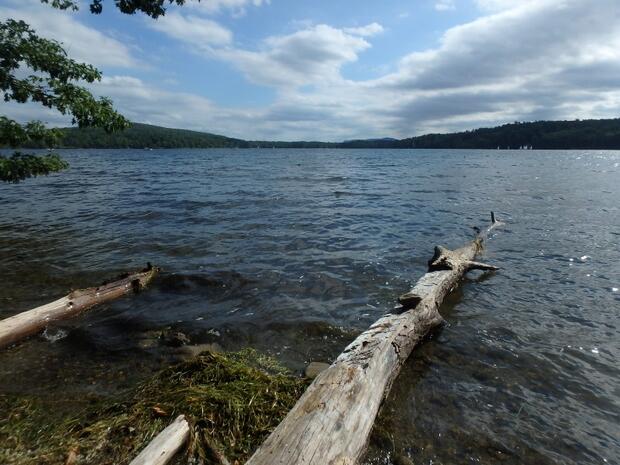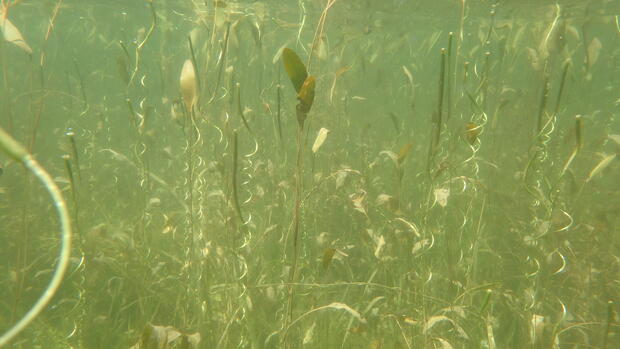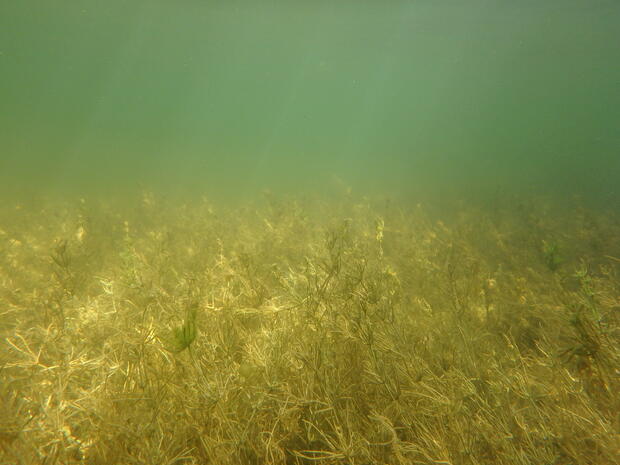- Scientific name: Marstonia lustrica
- Species of Greatest Conservation Need (MA State Wildlife Action Plan)
- Endangered (MA Endangered Species Act)
Description
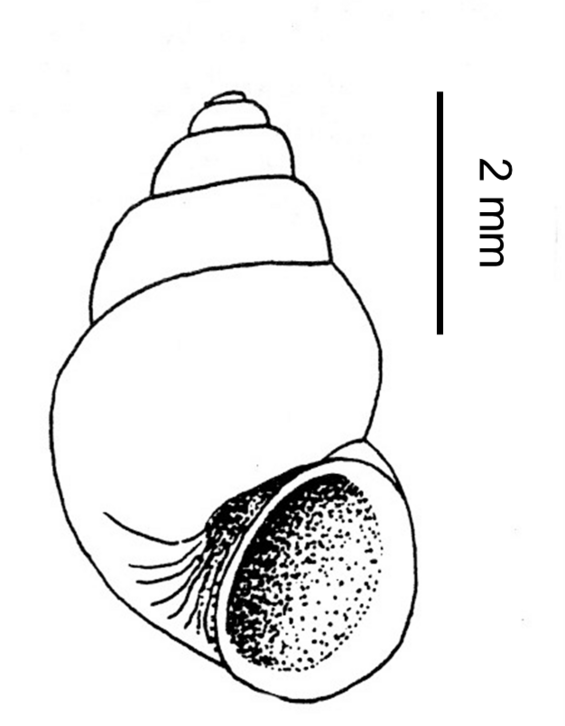
Smith, D.G. Keys to the freshwater macroinvertebrates of southern New England. Published by author. Sunderland, MA. 2000.
The boreal marstonia is a small snail that has a translucent shell with a light greenish or brownish color. The spiral shell is conical and thin, up to 6 mm (0.2 inches) high, and has 4 to 5 convex whorls with impressed sutures (Hershler 1994). The shell aperture (opening to shell cavity) is dextral (coiled to the right when facing observer) and has an operculum, a hardened circular structure that seals the shell. The operculum has a single obvious spiral that fans out to the perimeter (paucispiral). Identification of this species can be difficult because it requires knowledge of specific anatomical features of snails.
Boreal marstonia is most similar in appearance and co-occurs with the more abundant and widespread mud amnicola (Amnicola limosa), also in the hydrobiid group. Juveniles of these species cannot be reliably distinguished by morphology and require genetic analysis. Boreal marstonia adults may be distinguished by their detached aperture from the adjacent whorl and more conical shell but may vary by waterbody. Otherwise, examination of internal anatomical features is needed (Smith 2000).
Life cycle and behavior
Little is known about the life history of boreal marstonia. Snails in the hydrobiid group have separate sexes. Boreal marstonia likely has an annual life cycle. Presumably, adult females deposit single eggs enclosed in a protective capsule on other individuals of the same species or on the substrate (Smith 2000) likely in spring and summer months. Juveniles grow through the summer, grazing on algae, with adults dying back in the fall/winter months and juveniles burying in the substrate as water temperatures become cooler (Coote and Roeder 1999).
Distribution and abundance
The boreal marstonia is found at the eastern edge of its range in western Massachusetts. This species also occurs in New York, Pennsylvania, and southern Ontario west to states in the Great Lakes region and south to northern parts of the Mississippi River drainage. Populations in Massachusetts are likely glacial relicts (Coote 2019).
In Massachusetts, the population is limited to two lakes in the Housatonic River watershed where it’s threatened by various human activities. The species occurs throughout these waterbodies in patchy distributions and often at low abundances compared to other snail species (WRS 2017). Recent study in one lake shows a disjunct distribution with a possible meta-population structure (GZA 2017). It is listed under the Massachusetts Endangered Species Act as endangered. All listed species are protected from killing, collecting, possessing, or sale and from activities that would destroy habitat and thus directly or indirectly cause mortality or disrupt critical behaviors. In addition, listed animals are specifically protected from activities that disrupt nesting, breeding, feeding, or migration.
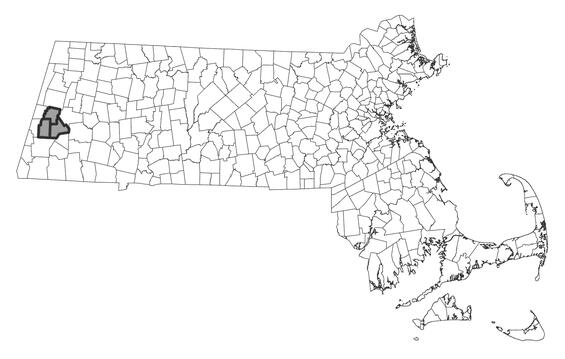
Distribution in Massachusetts.
1999-2024
Based on records in the Natural Heritage Database.
Habitat
Throughout its range, the boreal marstonia inhabits slow rivers and lakes and can be found on rocks and on submerged aquatic vegetation, such as Vallisneria, Potamogeton, and Chara spp. (Jokinen 1992). In Massachusetts, the boreal marstonia has been found in meso-eutrophic lakes with high alkalinity and calcium concentrations. Lakes support littoral zones with extensive submerged aquatic vegetation where moreal marstonia occurs. The species has been found in mixed and monotypic vegetation/macroalgal beds of Chara spp., V. americana, Potamogeton spp., Najas spp., and Myriophyllum spicatum with no apparent species association but rather a potential for increased occurrence in high species rich beds (GZA 2016). Where found, substrates typically range from sand to gravel, but the species has also been detected on siltier bottoms. Boreal marstonia has been detected up to 3-m (9.8 feet) in depth with recorded maximum abundances typically less than 2m (6.5 feet) (Ludlam et al. 1973, McLain 2003, GZA 2017, Otter 2023).
Healthy habitats are vital for supporting native wildlife and plants. Explore habitats and learn about conservation and restoration in Massachusetts.
Threats
Shoreline development, water level drawdowns, increased nutrient input, herbicides, loss of submerged aquatic vegetation, increased frequency of cyanobacteria blooms, and non-native snails (e.g., banded mystery snail) are potential threats to this species.
Conservation
Survey and monitoring
Past monitoring efforts at extant sites should continue to inform invasive wildlife and eutrophication management actions. Monitoring efforts are recommended at least every 5 years or as needed, including in response or prior to lake management activities. Other lake snail assemblages in the Housatonic River watershed have been sampled and have not detected boreal marstonia. However, survey effort should be reserved for previously sampled and novel waterbodies, particularly with new sampling methods including eDNA. Surveys should be conducted during summer months (July-Aug) when live adults are likely most available for detection (GZA 2017).
Management
Protection of boreal marstonia habitat is critical for species persistence in Massachusetts. Boreal marstonia occupies waterbodies with active lake management that aim to control aquatic invasive species including submerged plants and zebra mussels. Control and reduction of these species will improve boreal marstonia habitat; however, many strategies may negatively impact boreal marstonia directly or via habitat degradation including water level drawdowns, dredging, and excessive herbicide application. Careful consideration is warranted to balance protection of the current population with management of invasive species. Furthermore, watershed-scale nutrient management is needed to reduce nutrient input from shoreline and agricultural sources in occupied waterbodies. Deceleration of eutrophication rates can improve water quality and reduce cyanobacteria bloom frequency.
Research needs
Surveys should continue to target historical but also new waterbodies to better understand its distribution and relative abundance in Massachusetts. Physical surveys coupled with eDNA collections could improve detection of this locally rare species. Increased knowledge is needed of boreal marstonia phenology including active and dormant periods and its drivers (e.g., water temperature), timing of egg laying behavior, and adult dieback. Additionally, refinement of potential substrate preferences (e.g., sand, gravel) can help to better estimate lake-wide population size (GZA 2017). Toxicity effect concentrations of herbicides and molluscicides on appropriate surrogate snail species may be needed.
References
Coote, T. and D. Roeder. 1999. The relative abundance of Pyrgulopsis lustrica Pilsbry and its movements in Stockbridge Bowl, Stockbridge Massachusetts, September-December, 1999. Berkshire Environmental Research Center, Great Barrington, MA.
GZA, GeoEnvironmental Inc. 2016. Marstonia lustrica habitat assessment and survey results of the Stockbridge Bowl lake basin Stockbridge, MA, 2015 Field Season. Springfield, MA
GZA, GeoEnvironmental Inc. 2017. Marstonia lustrica survey results of the Stockbridge Bowl lake basin and outlet channel Stockbridge, MA, 2016 Field Season. Springfield, MA
Hershler, R. 1994. A review of the North American freshwater snail genus Pyrgulopsis (Hydrobiidae). Smithsonian Contributions to Zoology. Number 554: 75-77.
Jokinen, E.H. 1992. The Freshwater Snails (Mollusca: Gastropoda) of New York State. New York State Museum Bulletin 482.
Ludlam, S.D., K.S. Hutchinson, and G.E. Henderson. 1973. The limnology of Stockbridge Bowl, Stockbridge, Massachusetts. University of Massachusetts Water Resources Research Center, Completion Report FY-73-4. 59 pp.
McLain, D. 2003. Status of 4 state-listed snails in Western Massachusetts in 2002. Report to the Massachusetts Natural Heritage and Endangered Species Program.
Otter Environmental. 2023. Marstonia lustrica and submerged aquatic vegetation survey for Laurel Lake, July 2023. Southfield, MA.
Smith, D.G. 2000. Keys to the freshwater macroinvertebrates of southern New England. Published by author. Sunderland, MA. 243 pp.
[WRS] Water Resource Services. 2017. Laurel Lake drawdown summary report: 2010-2016.
Contact
| Date published: | March 10, 2025 |
|---|
